-
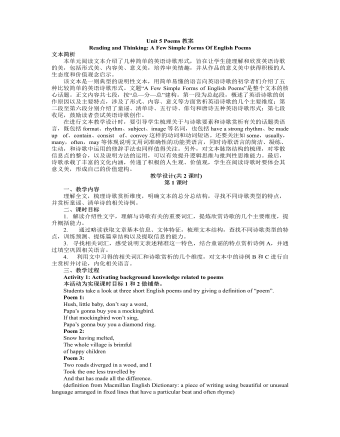
新人教版高中英语选修3Unit 5 Poems教案
本单元阅读文本介绍了几种简单的英语诗歌形式,旨在让学生能理解和欣赏英语诗歌的美,包括形式美、内容美、意义美,培养审美情趣,并从作品的意义美中获得积极的人生态度和价值观念启示。 该文本是一则典型的说明性文本,用简单易懂的语言向英语诗歌的初学者们介绍了五种比较简单的英语诗歌形式。文题“A Few Simple Forms of English Poems”是整个文本的核心话题。正文内容共七段,按“总—分—总”建构。第一段为总起段,概述了英语诗歌的创作原因以及主要特点,涉及了形式、内容、意义等方面赏析英语诗歌的几个主要维度;第二段至第六段分别介绍了童谣、清单诗、五行诗、俳句和唐诗五种英语诗歌形式;第七段收尾,鼓励读者尝试英语诗歌创作。 在进行文本教学设计时,要引导学生梳理关于与诗歌要素和诗歌赏析有关的话题类语言,既包括format、rhythm、subject、image等名词,也包括have a strong rhythm、be made up of、contain、consist of、convey这样的动词和动词短语。
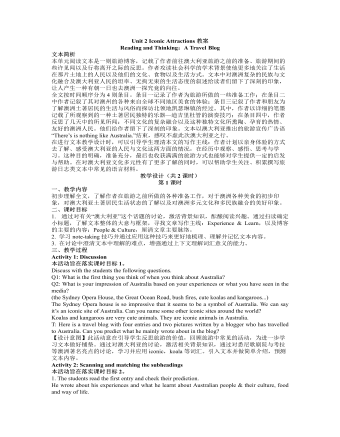
新人教版高中英语选修4Unit 2 Iconic Attractions教案
帮助学生通过讨论与对主题的提升,反思自己的旅游方式,以便做出更优化的安排,在今后的旅程中有更多的收益。 Activity 2: Further discussion of the 6 elements above and supplement of more background knowledge 本活动为实现课时教学目标2。 1.Target Q: The writer’s clear target of traveling, meeting the people and experiencing the culture, is closely related to his major in social studies. Then what is social studies? Social studies is a part of a school or college curriculum concerned with the study of social relationships and the functioning of society and usually made up of courses in history, government, economics, civics, sociology, geography, and anthropology. (Dictionary by Merriam-Webster) Reflection: When you go out to travel, what targets do you usually have in mind? 2.Research Q: Suppose you are traveling to Hangzhou during the school holidays, how will you do research on the city? (surf the internet, read books or travel brochures, consult friends, ...) What information will you be interested to know? (location, iconic sites, local cuisines, interesting customs, shopping malls ...) 3.Abandonment To make the most of time, we have to learn to abandon so that we can accomplish our plan. What will you be interested in doing if you go to Hangzhou if you have a week’s time? What if you only have 2 days? 4~5. Venturing & Experiencing Q: What did he venture to do during the trip? What new experiences did he have? In Sydney: attend his first open-air barbecue, enjoy many different but yummy meals In Catherine: observe the life and customs of the aborigines appreciate their music & try the musical instruments: the didgeridoo
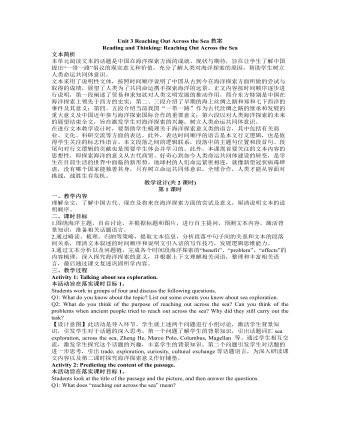
新人教版高中英语选修4Unit 3 Reaching Out Across the Sea教案
本活动旨在落实课时目标3。 Think about the following questions and talk about your own attitude in pairs.Q1: As for this topic,what impresses you the most in the passage?Q2: What do you think of the future of China’s further exploration in sea? Are you in favor of the further exploration?Why or why not? 【设计意图】该活动是一个完全开放性的活动,每个学生都会有不同的答案。运用迁移所学,自由口头表达自己对海洋探索的态度。对于中国海洋探索的未来,每个人的想法是不一样的,有乐观,有担忧,有认为值得投入,也有认为不值得付出太大代价,这里给学生自由表达的空间只要学会有支撑自己观点的事实就可以了,进一步培养学生批判性思维和正确的价值观。 Assignment: 此任务旨在迁移一、二课时所学,培养学生辩证分析问题的能力。 Write about your idea of the future of China’s sea exploration. And add your attitude towards the effort China have made in sea exploration. You’re expected to use the language and the writing technique learnt in the passage.
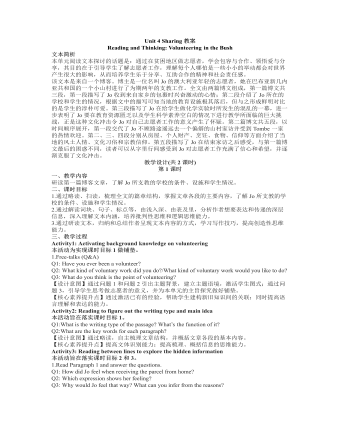
新人教版高中英语选修4Unit 4 Sharing教案
【核心素养提升点】学会将抽象信息进行可视化表达,提高信息处理能力和分析、推理等高阶思维品质;在跨文化交际中学会以国际视野接受和包容不同的文化。 5.Read Paragraph 2, draw a mind map and answer the questions. Q1:What did Jo learn about Tombe’s life? Q2:What kind of life do the natives lead? Read paragraph 2-5 and draw a mind-map. (Focus on accommodation, possession, diet and belief) 【设计意图】引导学生利用思维导图和问题链等形式来厘清当地人的生活方式,更好地处理和归纳信息 【核心素养提升点】提高信息处理能力、分析和归纳能力,包容异国文化、扩展国际视野。 6.Read Paragraph 3 and answer the questions. Q1:What was Jo’s feeling upon arriving her own home? Q2:Why would she feel that way? Q3:Do you think “It was such a privilege to have spent a day with Tombe’s family”? 【设计意图】通过提问,让学生理解Jo的苦并快乐的心情,并通过对“It was such a privilege to have spent a day with Tombe’s family”这句话的理解,体验志愿者生活的伟大。 【核心素养提升点】学会对信息的综合和归纳,从而理解作者所表达的观点。 Activity4: Summarize the change of Jo's feelings
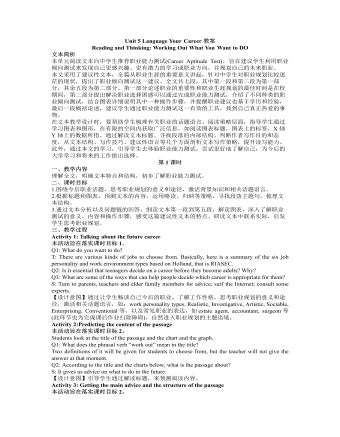
新人教版高中英语选修4Unit 5 Language Your Career教案
本单元阅读文本向中学生推荐职业能力测试(Career Aptitude Test),旨在建议学生利用职业倾向测试来发现自己更感兴趣、更有潜力的学习或职业方向,并规划自己的未来职业。 本文采用了建议性文本,全篇从职业生涯的重要意义讲起,针对中学生对职业规划比较迷茫的现状,提出了职业倾向测试这一建议。全文共七段,其中第一段和第二段为第一部分,其余五段为第二部分。第一部分论述职业的重要性和职业生涯规划的最佳时间是在校期间,第二部分提出解决职业选择困惑可以通过完成职业能力测试,介绍了不同种类的职业倾向测试,结合图表详细说明其中一种操作步骤,并提醒职业建议也基于学历和经验,最后一段概括论述,建议学生通过职业能力测试这一有效的工具,找到自己真正热爱的事物。 在文本教学设计时,要帮助学生梳理有关职业的话题语言。阅读策略层面,指导学生通过学习图表和图形,在有限的空间内获取广泛信息,如阅读图表标题,图表上的标签,X轴Y轴上的数据所指。
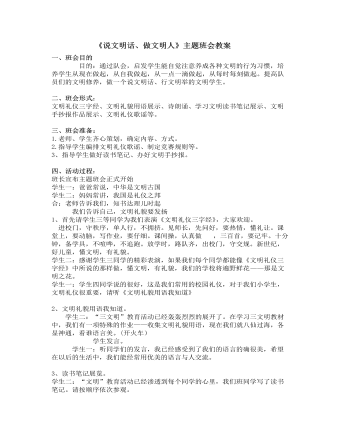
《说文明话, 做文明人》主题班会教案
2、文明礼貌用语我知道。学生二:“三文明”教育活动已经轰轰烈烈的展开了。在学习三文明教材中,我们有一项特殊的作业——收集文明礼貌用语,现在我们就八仙过海,各显神通,看谁语言美。(开火车)学生发言。学生一:听同学们的发言,我已经感受到了我们的语言的确很美,希望在以后的生活中,我们能经常用优美的语言与人交流。3、读书笔记展览。学生二:“文明”教育活动已经渗透到每个同学的心里,我们班同学写了读书笔记。请按顺序依次参观。4、文明手抄报展览。5、为获奖同学颁发奖状。(自制奖状)学生一:我们学了那么多,最终目的就是让我们“说文明话,行文明举,做文明人”。请欣赏〈文明礼仪歌谣〉
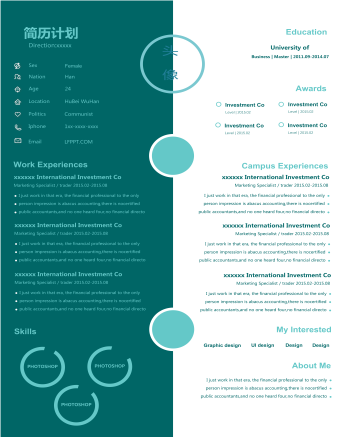
中英文简历
I just work in that era, the financial professional to the onlyperson impression is abacus accounting,there is nocertified publicaccountants,and no one heard four,no financial directo.
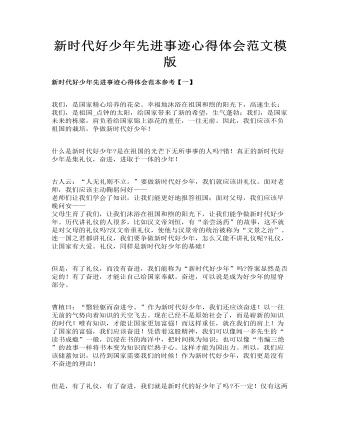
新时代好少年先进事迹心得体会范文模版
古人云:“人无礼则不立。”要做新时代好少年,我们就应该讲礼仪。面对老师,我们应该主动鞠躬问好——老师们让我们学会了知识,让我们能更好地报答祖国;面对父母,我们应该早晚问安——父母生育了我们,让我们沐浴在祖国和煦的阳光下,让我们能争做新时代好少年。历代讲礼仪的人很多,比如汉文帝刘恒,有“亲尝汤药”的故事,这不就是对父母的礼仪吗?汉文帝重礼仪,使他与汉景帝的统治被称为“文景之治”。连一国之君都讲礼仪,我们要争做新时代好少年,怎么又能不讲礼仪呢?礼仪,让国家有大爱。礼仪,同样是新时代好少年的基础!
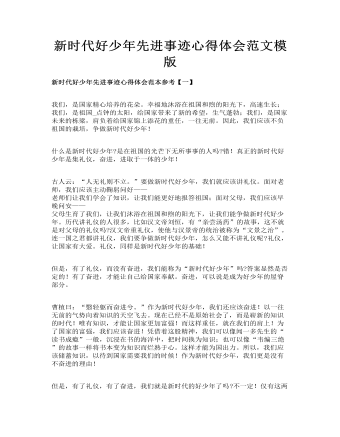
新时代好少年先进事迹心得体会范文模版
古人云:“人无礼则不立。”要做新时代好少年,我们就应该讲礼仪。面对老师,我们应该主动鞠躬问好——老师们让我们学会了知识,让我们能更好地报答祖国;面对父母,我们应该早晚问安——父母生育了我们,让我们沐浴在祖国和煦的阳光下,让我们能争做新时代好少年。历代讲礼仪的人很多,比如汉文帝刘恒,有“亲尝汤药”的故事,这不就是对父母的礼仪吗?汉文帝重礼仪,使他与汉景帝的统治被称为“文景之治”。连一国之君都讲礼仪,我们要争做新时代好少年,怎么又能不讲礼仪呢?礼仪,让国家有大爱。礼仪,同样是新时代好少年的基础!
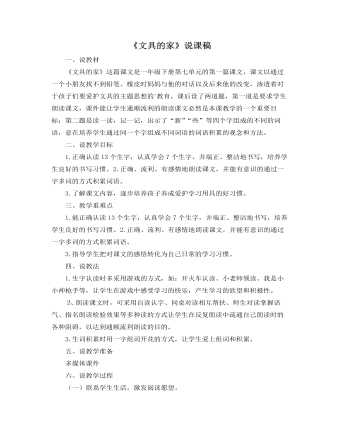
部编人教版一年级下册《文具的家》说课稿
一、说教材《文具的家》这篇课文是一年级下册第七单元的第一篇课文,课文以通过一个小朋友找不到铅笔、橡皮时妈妈与他的对话以及后来他的改变,渗透着对于孩子们要爱护文具的主题思想的`教育。课后设了两道题,第一道是要求学生朗读课文,课件能让学生通顺流利的朗读课文必然是本课教学的一个重要目标;第二题是读一读,记一记,出示了“新”“些”等四个字组成的不同的词语,意在培养学生通过同一个字组成不同词语的词语积累的观念和方法。二、说教学目标1.正确认读13个生字,认真学会7个生字,并端正、整洁地书写,培养学生良好的书写习惯。2.正确、流利、有感情地朗读课文,并能有意识的通过一字多词的方式积累词语。3.了解课文内容,逐步培养孩子养成爱护学习用具的好习惯。
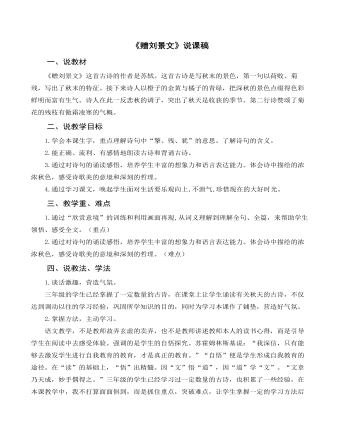
部编人教版三年级上册《古诗三首 赠刘景文》说课稿
一、说教材《赠刘景文》这首古诗的作者是苏轼。这首古诗是写秋末的景色,第一句以荷败、菊残,写出了秋末的特征。接下来诗人以橙子的金黄与橘子的青绿,把深秋的景色点缀得色彩鲜明而富有生气。诗人在此一反悲秋的调子,突出了秋天是收获的季节。第二行诗赞颂了菊花的残枝有傲霜凌寒的气概。二、说教学目标1.学会本课生字,重点理解诗句中“擎、残、犹”的意思。了解诗句的含义。2.能正确、流利、有感情地朗读古诗和背诵古诗。3.通过对诗句的诵读感悟,培养学生丰富的想象力和语言表达能力。体会诗中描绘的浓浓秋色,感受诗歌美的意境和深刻的哲理。4.通过学习课文,唤起学生面对生活要乐观向上,不泄气,珍惜现在的大好时光。三、教学重、难点1.通过“欣赏意境”的训练和利用画面再现,从词义理解到理解全句、全篇,来帮助学生领悟、感受全文。(重点)2.通过对诗句的诵读感悟,培养学生丰富的想象力和语言表达能力。体会诗中描绘的浓浓秋色,感受诗歌美的意境和深刻的哲理。(难点)
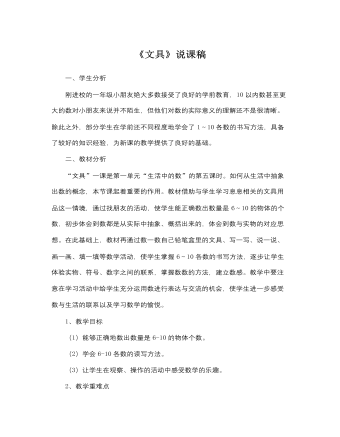
北师大版小学数学一年级上册《文具》说课稿
一、学生分析刚进校的一年级小朋友绝大多数接受了良好的学前教育,10以内数甚至更大的数对小朋友来说并不陌生,但他们对数的实际意义的理解还不是很清晰。除此之外,部分学生在学前还不同程度地学会了1~10各数的书写方法,具备了较好的知识经验,为新课的教学提供了良好的基础。二、教材分析“文具”一课是第一单元“生活中的数”的第五课时。如何从生活中抽象出数的概念,本节课起着重要的作用。教材借助与学生学习息息相关的文具用品这一情境,通过找朋友的活动,使学生能正确数出数量是6~10的物体的个数,初步体会到数都是从实际中抽象、概括出来的,体会到数与实物的对应思想。在此基础上,教材再通过数一数自己铅笔盒里的文具、写一写、说一说、画一画、填一填等数学活动,使学生掌握6~10各数的书写方法,逐步让学生体验实物、符号、数字之间的联系,掌握数数的方法,建立数感。
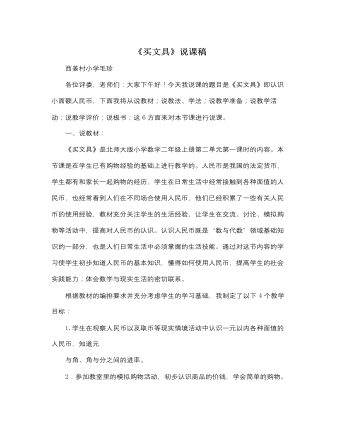
北师大版小学数学二年级上册《买文具》说课稿
(一)、情境导入通过播放笑笑和淘气在文具店购买文具活动的视频片段,唤起学生已有的知识和经验,使学生想到“买东西要使用人民币”。又因为二年级孩子年龄较小,社会经验不足,上市场、超市购物的机会也少,对人民币只是初步的认识,对于要用到钱才能买到东西这一朴素的等价交换的原则只有初步的意识。所以借此机会激发学生想不想和笑笑、淘气一起到文具店里去购买文具呢?从而引出课题:买文具。(二)、认识小面额人民币学生在生活中经常看到人民币,有时还使用人民币,因此我首先让学生互相交流:你知道有哪些面值的人民币?根据学生的回答,老师有序地进行板书:1角、2角、5甬1元、2元、5元10元、20元、50元100元在这一环节中我仅作为引导者,引导学生相互交流,在师生互动中完成对已有知识经验的归纳与延伸,通过小组合作,互相交流,让全体学生参与学习过程,在学习过程中有意识培养学生细心观察、仔细倾听、善于总结的良好习惯。
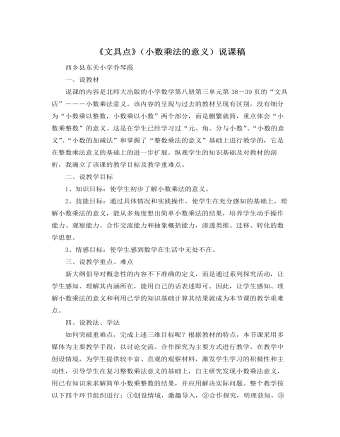
北师大版小学数学三年级上册《文具点》说课稿
(三)深化运用,巩固新知在这个环节,我设计四组闯关题。第一关是试一试:①买3支铅笔需要多少元?②买两把直尺需要多少元?这关是模仿性练习,让学生运用已学的数学知识解决实际问题。第二关是说一说,在学生初步感知了小数乘法的意义后,我给出了6个算式,让学生说一说他们所表示的意义。第三关是填一填,即根据加法算式写乘法算式和根据乘法算式写加法算式,这两关是提高性练习。第四关是涂一涂,即根据算式涂涂得出结果。是为了进一步加深学生对小数乘法意义的理解。第五关是想一想:0.3×4=0.6,4×0.3=?这关是深化性练习,一是让学生明白整数乘法的交换律在小数乘法中同样适用,二是让学生体会一个整数乘小数的意义也是求几个几是多少。第六关是两组口算练习。第七关是两道解决问题。主要是在学生理解小数乘整数的意义的基础上复习以前所学的数量关系。
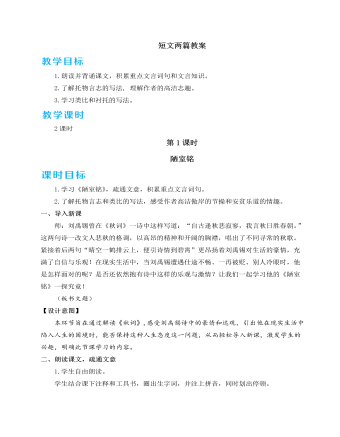
人教部编版七年级下册短文两篇教案
本课由两篇短小易懂、文辞优美的文言文组成,针对这一特点,本课设计分为两课时,先通过教读《陋室铭》学习托物言志,再通过自主学习《爱莲说》来理解托物言志,采用先教后学的模式进行教学。在《陋室铭》教学中,设计“朗读”“品读”“析读”“联读”四个环节,逐层深入,在读中明特点,读中明志趣,读中析写法,读中悟主旨。以诗人积极的人生态度、豁达的胸襟为行文线索,从文本出发,深入解读文本,让学生逐步理解诗人面对苦难仍能坚守自我的人生态度和高尚情操,同时让学生学习托物言志的手法,了解这类文章的特点。《爱莲说》采取自主学习的模式,分两步进行。先运用上节课的四个环节,在老师的指导下,进行自主合作学习。老师给予学生自学方法,并适时引导,让学生逐步完成学习任务,以此理解文章内容,提高学生自主学习文言文的能力;再采用竞赛的方式展示学习成果,以几个不同形式的比赛,来激发学生的学习兴趣,让学生在竞赛中夯实文言文的基础知识,在竞赛中加深对文章的理解,学会探究。本课整个教学设计思路清晰,教学方法可操作性强。
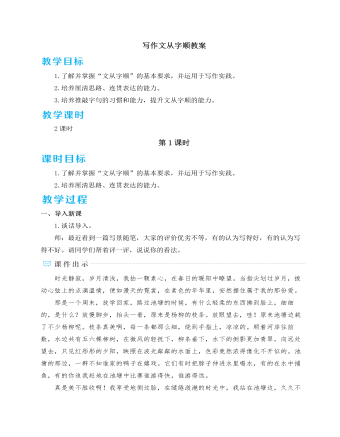
人教部编版七年级下册写作文从字顺教案
二、升格训练师:大文豪曹雪芹写《红楼梦》是“披阅十载,增删五次”,可见修改是写作获得成功的必然环节,很多文学名家对此也深有感触。这些古今中外的作家,都向我们推荐了一种修改文章的好方法——朗读修改法。结合你自己的写作经验,你觉得大声朗读可以发现习作中的哪些问题?预设 如有些词语听起来不顺耳,有些句子读起来不顺口,有些段落缺少过渡,或前后意思重复,有些地方表达不清楚,有些修辞手法的运用欠妥,有些标点的运用不规范等,这些问题都能够在朗读中发现。2.再改随笔。师:之前修改写景随笔,用的是默读修改法,这次换作朗读修改法,会不会有新的收获呢?请大家朗读病文,然后小组讨论:文中还有哪些用词不恰当、语句不连贯的地方,找出来并进行修改,使之文从字顺。(生朗读随笔,修改后交流讨论并展示)预设 (1)“有什么轻柔的东西拂到脸上,细细的”,可以把“轻柔的”改成叠词“柔柔的”,放到后面,和“细细的”并列,这样读起来音律感要好些。
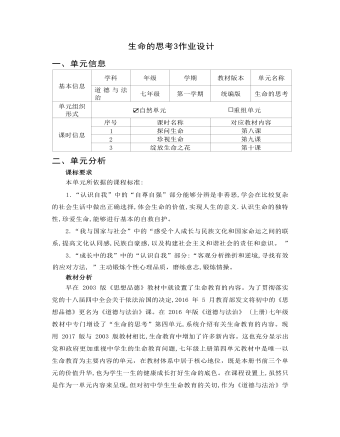
初中道德与法治七年级上册生命的思考3作业设计
一、单项选择题1.C 此题考查生命的特点,AD 选项前面说的都对,但是后面说的都不对。因为: 人生难免风险、挫折和坎坷,是逃离不了的,拒绝不了的。生命是独特的,不能 相互替代,所以 B 也是错的。C 符合题意正确。 2.①②③都体现对生命的尊重和敬畏,而④表达的是一种消极避世的人生态度 ; 因此错了。所以,正确答案 D。3.最美逆行不是没有安全意识,相反,他们能做到敬畏生命,坚持生命至上。因 此,②选项错了,其他选项都符合题意。所以正确答案是 D。4. (1) 主题是:敬畏生命(2) 图 1,祭奠生命,表达对逝者的追悼和怀念。这么做是为了悼念生命,体 现对生命的尊重,体会生命之间是息息相关的。图 2,生命是崇高的、神圣的,是任何代价都换取不来的。我们对生命要有一种 敬畏的情怀。
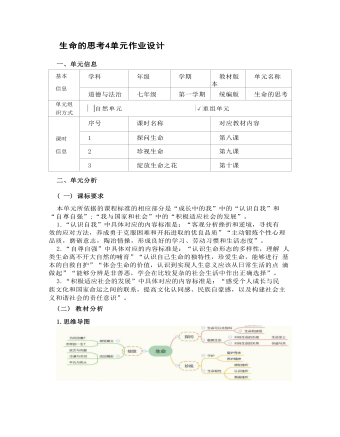
初中道德与法治七年级上册生命的思考4作业设计
①②③分析题干中,我们生命的意义不在于长短,而在于对社会的贡献,将个体生 命和国家的甚至人类的命运联系在一起时,生命就会闪耀出伟大,活出自己的精彩,让 生命更加绚烂,故①②③说法符合题意;④“追求生命个性和韧性”说法不符合主题故 ④说法错误;2.C【设计意图】该题考查呵护食品安全,珍爱生命。 ④说法虽然正确的,但是主体不符,不是市民的做法。故不能入选。 3.A【设计意图】本题考查对生命的传承。①②④材料中的话意在告诉我们,在人类生命的接续中,我们应该为自己的生命找 到一个位置,担当一份使命;在生命的传承关系中,我们应该正确认识和面对自己的生 命;我们每个人都不仅仅是在身体上接续祖先的生命,也在精神上不断继承和创造人类 的文明成果,故①②④说法正确;③生命属于我们每个人,生命的接续和发展与我们每 个人息息相关,故③说法错误。

初中道德与法治七年级上册生命的思考作业设计
B 等级——较积极参与采访活动;采访思路较清晰,记录较完整;能对自己的生 命观、价值观有所反思;能主动展示心得体会。C 等级——基本上能参与采访活动,遇到困难会想放弃;记录信息较少,只有少 量与主题有关;对自己生命观、价值观理解不深;有一点成果反馈,内容过于简 单。总体评价结果: (四) 作业分析与设计意图这是一项基于素质教育导向的整体式课时作业设计,以培养学生核心素养为 目标。作业以学生的“生命故事访谈”为主要情境,以填写活动记录的形式呈现。 教师从“参与态度、思想认识”等四个维度对作业进行评价,以“优秀、 良好、 合格”三个等级呈现。本次实践性作业是访谈型作业,课前采访希望通过学生的 参与,一方面锻炼学生的人际交往能力和口头语言表达能力,另一方面扩展学生 的生活阅历,从他人的精彩故事中获得启示,激发学生对生命的热情,树立正确 的人生观,同时也为下一框题的“平凡与伟大”提供教学素材,活出自己生命的 精彩。
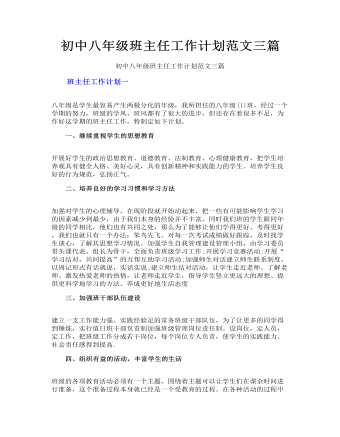
初中八年级班主任工作计划范文三篇
二、培养良好的学习习惯和学习方法 加强对学生的心理辅导,在现阶段就开始动起来,把一些有可能影响学生学习的因素减少到最少,由于我们本身的经验并不丰富,同时我们班的学生跟同年级的同学相比,他们也有共同之处,那么为了能够让他们学得更好、考得更好,我们也就只有一个办法:笨鸟先飞。对每一次考试成绩做好跟踪,及时找学生谈心,了解其思想学习情况。加强学生自我管理建设管理小组,由学习委员带头课代表、组长为骨干,全面负责班级学习工作;开展学习竞赛活动;开展“学习结对,共同提高”的互帮互助学习活动;加强师生对话建立师生联系制度,以周记形式有话就说,实话实说;建立师生结对活动,让学生走近老师、了解老师、激发热爱老师的热情,让老师走近学生,指导学生竖立更远大的理想、提供更科学地学习的方法、养成更好地生活态度



